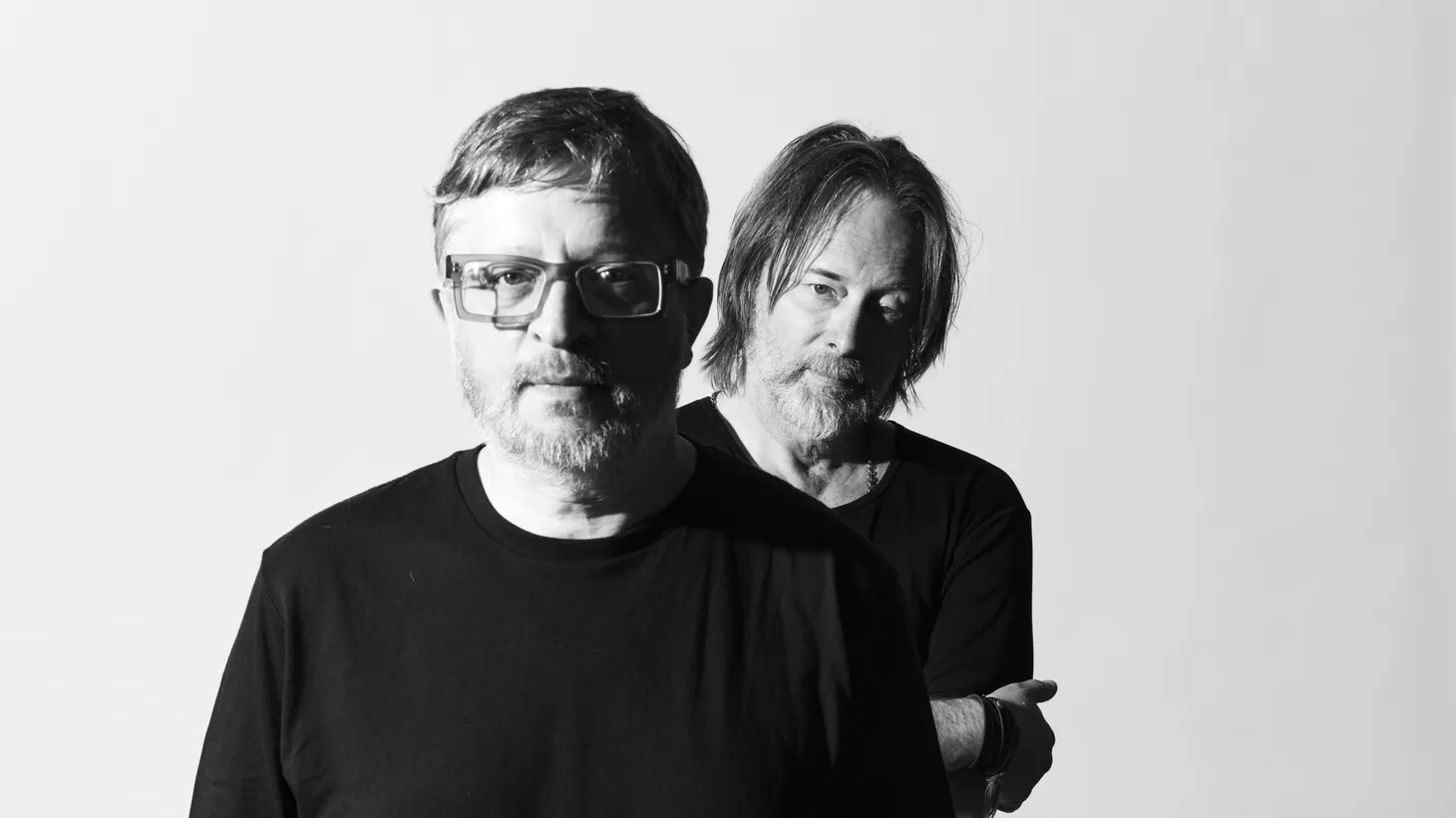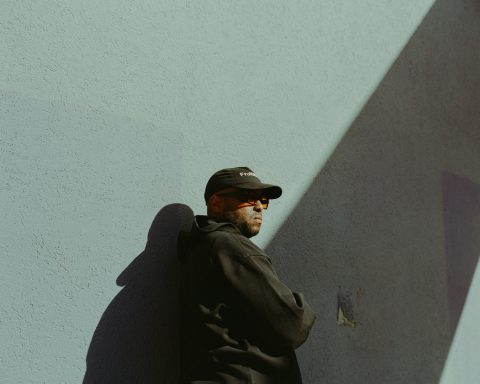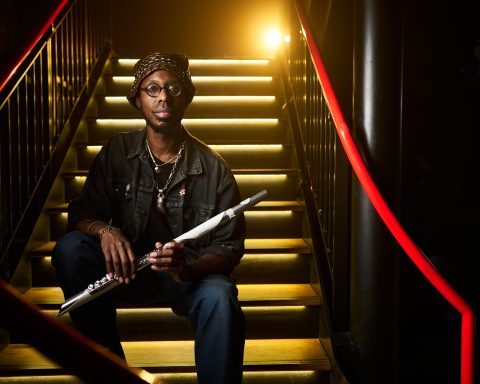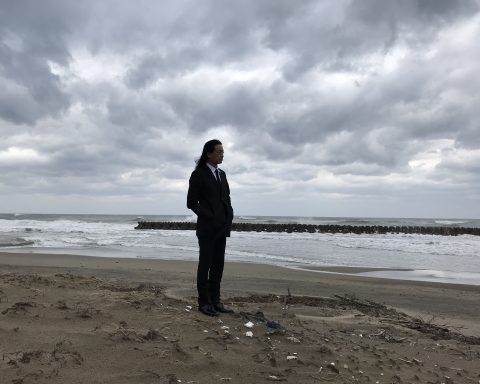Emerging from the early ’90s rave scene in South West England, Mark Pritchard became one of that golden era’s most prolific UK electronic music producers. From Global Communication and Jedi Knights with Tom Middleton to drum and bass for LTJ Bukem’s Good Looking Records and the glitch/dub/juke of Africa HiTech, he has worked under a dizzying array of aliases. When Pritchard signed to Warp Records in 2005 with his Harmonic 33 project, it was a natural home for a futurist who loves the beautiful imperfection of analog. We caught up with him around the release of Tall Tales, a musical and cinematic collaboration with Thom Yorke and Australian visual artist Jonathan Zawada.
The Early Rave Scene
Where did you first experience electronic music?
The first places were the free parties happening in the West Country. Then I started going into Bournemouth to this club called Kevin’s House. It was a 200-capacity club with lasers and a smoke machine. They had two really good DJs called North and South playing everything—Chicago house, Detroit techno, New York house, and the seeds of English dance music. So I was really lucky to have that.
It must have been inspiring to experience that at such a young age.
It was amazing because I got to hear all this incredible music in a safe space on a good system. That is where I would first hear things like Marshall Jefferson’s “Move Your Body” and Frankie Knuckles’ “Your Love” mixed up with early UK breakbeat with the Jamaican sound system bass.
Getting into Production
How did you go from clubber to music maker?
I used to DJ at house parties and at a club in Taunton where I put on a party with some friends from school. It quickly evolved into getting equipment and starting to make music. Our first release as Shaft [with Adrian Hughes] was a cartoon rave anthem, “Roobarb & Custard.” That went top ten, which meant I could leave my job to focus solely on the music. I also had money to buy more gear and set up a small studio in the house.
What equipment were you using in those early days?
My first sampler was a FZ-1. I later got a S950. Roland gear-wise, I had a Roland JUNO-106, SH-101, SH-202, TB-303, Alpha Juno-1, JUPITER-6, RE-301 Chorus Echo, SBF-325 Stereo Flanger, and an AP-2 Phase II pedal. At that point, it was all quite affordable. You could get a JUNO-106 for around £100, a 101 for £150, and I think I paid about £100 for my 303. The JUPITER-6 was a bit more but not too much, maybe £400. Then I had a friend who had a JUPITER-8, and I used to go to their studio and mess around with that.
"The SH-101 is a really good synth to learn on because you've got the basics. You can select what waveform you want to use."
Inside the Machines
This was the days before YouTube tutorials. How did you navigate your way around all the equipment?
Once I learned the basics, I found it quite straightforward. The 101 is a really good synth to learn on because you’ve got the basics. You can select what waveform you want to use. You’ve got the LFO and then the envelope/filter envelope. Once you start to learn what these things do it’s quite simple. And once you’ve learned that on one synth, it transposes onto all of them. Even on a three-oscillator synth, it can look complicated at first, but it’s often multiples of the same thing. Later on, I got a Minimoog, and that’s also really good for learning the basics.
You’ve spoken before about the imperfections and mistakes you can get from analog equipment.
Yeah, you don’t quite know what’s going to happen. Whether it’s going to drift or you load the wrong MIDI sequence into the wrong track. I always used to do it with the drum pattern, accidentally sending that to the bass track. And there was often something good about that. Then, the synching was always interesting. Say you have the 808 as your master and the CV (control voltage), and the gate comes out of that to trigger a 101. It will have a slight delay which can be a good thing.
Keeping it Mysterious
Why did you decide to work under so many different aliases?
I always liked the mystery of white labels and those old Underground Resistance 12-inches when you didn’t know who the artists were. Sometimes, there wasn’t even any name on the label. I did love all that, but it also had to do with allowing me to release more records at the same time under various names and not be pre-judged because of what people expected from me.
And it gave you the freedom to release many different types of music.
Yes, we were going from a Detroit techno record, then an ambient thing, then a New York house record, then a jungle release. So it meant the music could be accepted just for the music. For example, when we did the hip-hop thing with Harmonic 33 [with Dave Brinkworth], nobody knew it was us, so it would take them by surprise when they found out. But I don’t recommend having so many different names, maybe just one for each genre, not twenty-plus.
"I always liked the mystery of white labels and those old Underground Resistance 12-inches when you didn't know who the artists were."
Sonic Explorer
Do you set out to make different music?
It definitely happens where I have a song template saved as a juke/footwork tune, and when I come to use it for my writing it turns into an ambient tune. I don’t really think, “Oh, today I’m going to do a techno record or whatever.” I just let the music guide me. I mean, the synths guide me a lot of the time. But I’m always weary. You don’t want to be accused of jumping on a style, so I make it authentic to the music while putting my own things in there. But the aim is for the DJs known for that kind of music to play, be it Kenny Dope and Louie Vega playing the house record I’d made or Fabio & Grooverider the drum and bass.
Do you think your environment in South West England affected your sound?
There is something in that ambient folk thing that some people have mentioned. I can also hear that in Richard/Aphex Twin’s music. He’s also from the South West. There is a lot of mythology in that area, with the stone circles and all of that. I’m also really into both traditional folk music and groups like Pentangle, so some of that must come through.
"There is a lot of mythology in South West England, with the stone circles and all of that. I'm also into traditional folk music and groups like Pentangle, so some of that must come through."
Telling Tales
How did you come to make a whole album with Thom Yorke?
It was during COVID, and Thom asked me to send him some music. At the time, he was doing the Smile LP. But after a few months, he started sending me two or three demo songs a day. The first three were “A Fake in a Faker’s World,” “The Men Who Dance in Stag’s Heads,” and “Wandering Genie.” And I was like, “These are good!” Some things he sent me didn’t have lyrics—just made-up words with him trying to find where he would sit in the song, sonically and melodically.
On Tall Tales, you worked with Steve Christie at Vintage Keys studio. He seems like a bit of a Joe Meek kind of sonic wizard. How do the two of you work together?
We do it over Zoom. He’ll have me on an iPad and take me around the studio, and I’ll talk to him about which equipment I want him to use. So that might be replacing what I have given him from a plug-in with an old synth and piano. Steve is great at knowing what sound I want.
How did the visual concept come to life?
It all started with Thom’s lyrics and evolved with Jonathan, who started to come up with these imagery ideas. I think Thom thought, “How are you going to do all this? It doesn’t seem feasible.” He was like, “All of these ideas are really good. Why don’t you just pick one?” I mean, if he had just used the “Gangsters” world, that would have been amazing. But all these different ideas started to tie in.
For the Love of Analog
You’re still collecting analog gear. Are there any holy grails for you?
I’ve always wanted the Maestro Ring Modulator because that’s what they must have used in THX 1138 [George Lucas’ sci-fi debut] for all the weird spoken-word stuff. I would love a Roland 909 and to get another 808. I really like the Roland TR-707 and TR-727, but they don’t come up for sale very often, and if they do, they’re in America or Japan. The hardest thing with the old gear is keeping it running.
"I mean, if Jonathan had just used the 'Gangsters' world, that would have been amazing. But all these different ideas started to tie in."
Do you mainly use digital or analog gear these days?
Most of the time, it’s a combination. Other times, it’s all plug-ins or all analog. I might start analog and then add stuff from plus-ins layered over the top. I try not to think about it too much; it’s more a case of what will add most to the music. But I do really love the sounds, quirks, and character of analog. It’s more fun to turn knobs and be hands-on.







